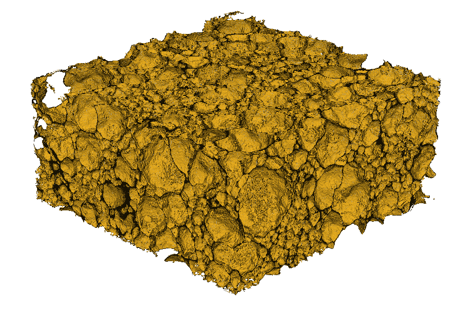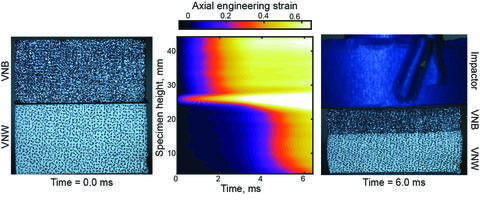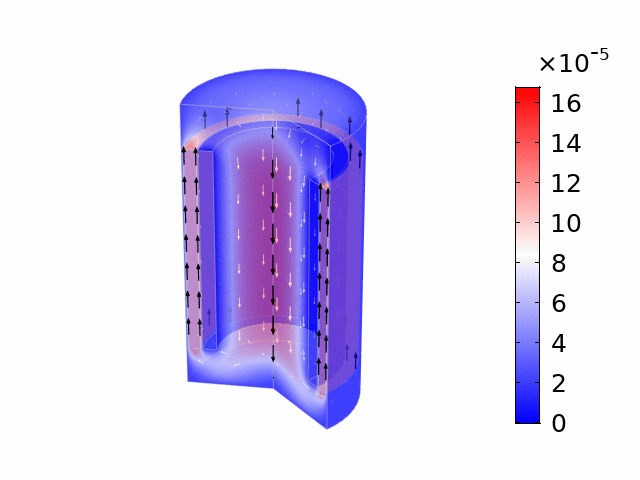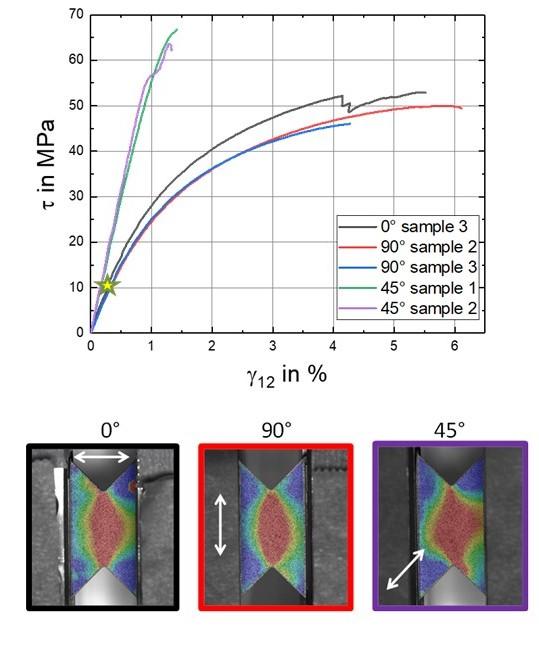Summary
First responders, athletes, consumers, and the military rely on protective equipment to prevent blunt trauma from an impact. Understanding of the relationship between blunt impact and soft tissue damage continually improves. This drives performance standard updates for protective equipment. To address the protection problem for blunt impact, novel dissipative materials, metamaterial architectures, and colloidal jamming materials are promising engineering solutions. Sufficient tools to enable rapid material discovery and design for impact mitigating materials (IMM) are not generally available. This project focuses on three main areas: in-situ metrology development; building and populating experimental data repositories; and, inverse property identification techniques to create a materials by design framework for non-linear materials.
Description
Overview
This project develops fundamental structure-property measurements on model materials and novel material chemistries from quasi-static to dynamic rates. The goal is to foster a materials by design approach for novel energy dissipation and force re-direction mechanisms.

Processing-Structure: Impact mitigating materials often utilize hierarchical structures that contribute to energy absorption. High resolution imaging methods such as micro X-ray computed tomography (µCT), optical and electron microscopy, and chemical spectroscopy are used to quantify and classify structural parameters as a function of production processes.

Material Properties: Impact mitigating materials exhibit non-linearity, temperature, strain, and strain rate dependent mechanical properties that may be correlated via viscoelasticity and thermal property measurements for viscoelastic properties, rheology, glass transition temperature, free volume or crystallinity. These properties can often be linked to micro- and meso-scale structures.
Mechanical Performance: This project is closely aligned with the Materials and Systems for Protection Against Penetrating and Blunt Force Phenomena, where metrologies are developed to provide quantitative material data under multi-axial, dynamic loading scenarios. We focus on development of in situ material measurement, such as digital imaging correlation and ultrasound, and properties identification, such as finite element model updating and virtual fields methods, to link the physical changes in material to the impact response functions.
Material Datasets: Material structure, property, and performance data is organized into hierarchical data formats tailored to more efficiently pass data between project team members, collaborators, and integrate into data repositories. The goal is to establish NIST as the resource for validated dynamic performance data for materials.
Models & Design Guidelines: Computational material models are developed within the project or with collaborators. In particular, by developing open frameworks the identification of material model parameters through finite element updating and virtual fields methods. Modeling results inform the processing-structure-property-performance relationships with a goal to support machine learning concepts in impact mitigation materials.
Current Focus Areas
Structured, soft materials: A key challenge for material development is the ability to rapidly translate between idealized experiments (e.g. quasi-static uniaxial stress or elevated-rate uniaxial strain measurements), fine-grain computational simulations, and real-world system performance. The current focus integrates high fidelity digital image correlation measurements into the current mechanical testing framework. We have built tools to capture full- or partial-strain field measurements and quantify measurement error. This information has been used to understand force transmission across interfaces or between impedance mismatched layers, as shown in the figure below.

Models and Design Guidelines: This is a new area for this project and reflects the underlaying materials-by-design approach. Full-field measurements unlock several routes for identifying material behavior, especially for dynamic measurements. For measurements with partial full-field data, the project is exploring Finite Element Updating (FEMU) or Constitutive Equation Gap Methods (CEGM). Both techniques can rapidly capture and iterate on material model parameters. For full-field measurements spanning the entire specimen, the virtual fields method (VFM) can be more computationally efficient and precise. For linear constitutive laws, the material parameters are found directly with strategic selection of virtual fields, for example in composite shear measurements below. Future efforts will expand to non-linear materials, where the constitutive parameters are found by solving a minimization function based on the principle of virtual work.
Orthogonal Flows for Complex Fluids: Complex fluids such as suspensions, emulsions, and polymeric liquids widely exist in our everyday life and are essential to many vital industries. The multicomponent nature of complex fluids renders diverse microstructures spanning over multiple length scales which dictate their macroscopic properties, and ultimately, their processability and application. Complex fluids play a significant role as robust impact mitigating materials. Recently, orthogonal flow fields have shown promise for understanding the physics of particle contact that occur a function of viscosity change. We have developed a crucial calibration procedure for a commercial shear rheometer for orthogonal superposition measurement and have validated the sources of experimental error through computational fluid dynamics simulations. The results of this work are critical for the academic and industrial users to apply this technique for scientific research and product development to achieve high measurement quality and productivity.

Intra- and Inter-laminar Properties in Structural Composites: Accurate measurements of shear properties are important in the response of structural materials to extreme events. Shear stiffness metrologies can highlight strengths and weaknesses in intra- or interlaminar properties. We apply digital image correlation techniques (2D and surface 3D) to V-notch shear methods to quantify the components of the composite stiffness tensor. Recently, we demonstrated the successful measurement of shear modulus for a thin section glass fiber composite. Current work employs the virtual field method to rapidly quantify stiffness parameters and quantify error contributions in a single test.

Major Accomplishments
Project Publications:
2020
End effect correction for orthogonal small strain oscillatory shear in a rotational shear rheometer [link: https://doi.org/10.1007/s00397-019-01185-5 ] Rheologica Acta
Data Publications:
2020

